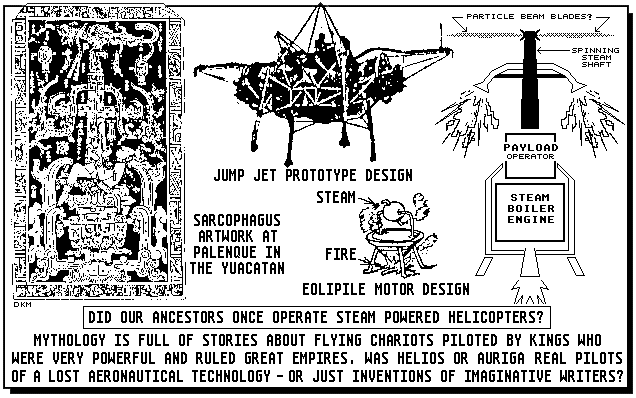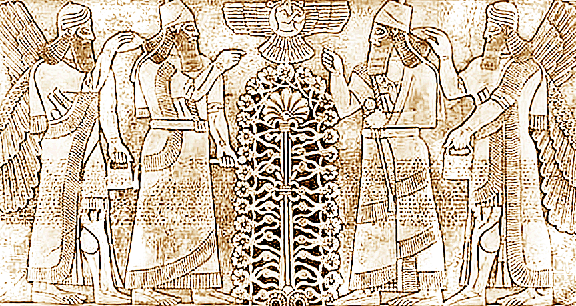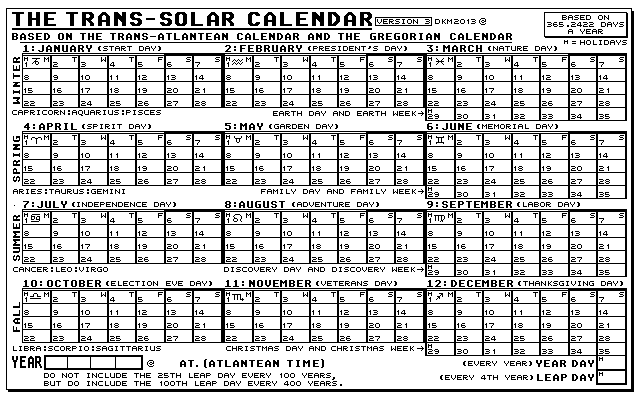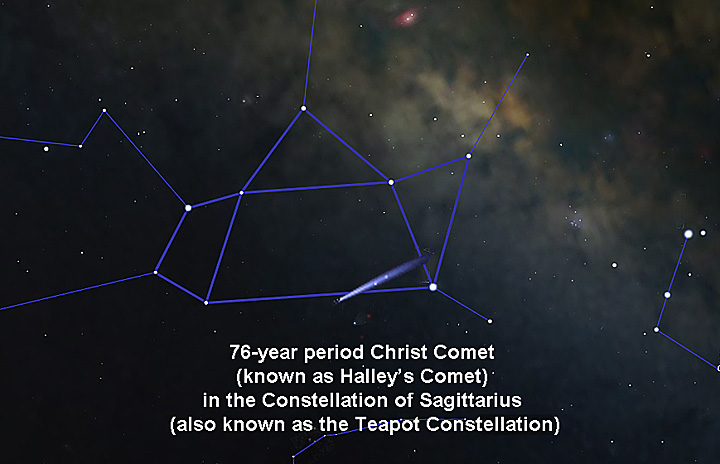

I have recently stumbled across several Youtube videos that suggest the birthday mass event of Christ in late December was made up by religious scholars many centuries ago to accommodate ancient pagan celebration rituals which have no relationship to the birth of Christ and his teachings.
These videos also suggest that the modern day imagery of the Christmas season -- like the character known as Santa Claus and Christmas trees, can be traced back to pagan ceremonial activity in northern Europe and ancient Assyria.
However, in my opinion, these videos and other similar views are misleading viewers into believing that some kind of conspiracy exist behind the important annual event ceremony of Christmas.
To try correct this misunderstanding, I would like to present several new theories that suggest some aspects of the origin of Christmas can be traced all the way back in time to -- you guessed it, the antediluvian age of Atlantis.
Now, before I try to explain my theory about when and what event may be responsible for the Christmas season -- which is a based on a very complex story of annual timekeeping by our ancient ancestors, let's begin reviewing three fascinating primary imagery concepts behind the modern day Christmas season ceremony.
The first is the amazing Santa Claus story who flies his magical craft all over the world in one night to deliver presents to deserving children, the second seasonal Christmas story is the idea about a remarkable conical shaped sparkling Christmas Tree that gives light to darkness, and the third imagery concept behind modern Christmas is the peaceful Nativity scene event story of baby Jesus in a manger.
Okay, much of the conventional Santa Claus image story is based on some Christmas poems written less than two centuries ago that describes a jolly old man who pilots an amazing airborne vehicle and gives out joy in the form of presents. These views are believed to be based on an mixture of older stories about a seafaring Saint Nicholas from Asia Minor who sailed around Europe giving annual presents to kids and a bearded Norse father-like character from long ago who was named Klaus.
But the earliest story about a flying vehicle that was piloted by a god-like being can be found in the Holy Bible and in Greco-Roman Mythology -- which includes Plato's description about what lies at the center of the city of Atlantis.
Notwithstanding Biblical stories about Ezekiels' vision of a flying helicopter-like aircraft piloted by God almighty himself which had "wheels within wheels" that made a great "whirling noise" and giving rides to ancient scholars like Enoch and Ezekiel, is the wondrous story as described by Plato about the elaborate "hangar temple" in the center of the city of Atlantis which sheltered a fascinating "chariot with winged horses".
Much like other mythical aircraft from Greco-Roman times such as Auriga, Apollo and Helios, these ancient flying helicopter-like vehicle designs from long ago could have been elaborately decorated aerial platforms powered by steam "eolipile motors" that drove shafts connected to "sparkling particle beam" props.
Perhaps the idea that real flying machines once existed in antediluvian times is a concept which needs further scientific study.
Such was the technology from the Atlantean age that was lost during the Biblical Flood event.

Did our Atlantean ancestors ever operate flying machines?
Regarding lost Atlantean technology and remarkable things like "sparkling particle beam" props, the visual origin of the Christmas Tree is also related to a time when the Atlanteans created powerful tools that looked like pointed "burning bushes" on a small scale and large "pillars of pale light" on a large scale.

Was the Tower of Babel actually a pillar of plasma energy?

Was Nimrod's tower ever imaged as a fiery pillar?
Now, I'm not sure how anyone could see the Norse "Yule Tree Log" ceremony story ever matching the imagery of a modern Christmas tree because a burning log -- vertical or horizontal, does not really resemble a colorful Christmas Tree -- so, let's put aside the idea that Christmas Trees are related to burning "Yule Logs".
Before I explain the conical "sparkling device" story once used by the Assyrian King by the name of Nimrod, let me first explain another imagery aspect to the Christmas Tree story by describing the Hanukkah Menorah lampstand counting tool used during the longest night of the year.
Not only did this lampstand device give light to the darkness, but it was used as a Hebrew calendar counting tool during Hanukkah to measure the nights at the end of the annual year.
Because the Hebrews used a seven-day week count of time that only adds up to 364 days a year, the eight candle Hanukkah Menorah lampstand counting tool was used during a timekeeping ceremony to "add" the extra "year day" every year and take the annual count to 365 days a year. Moreover, the nine candle version of the lampstand was used to count and "add' the "pass-over day" or "leap day" every four years to make 365.25 days a year.
Quite a remarkable counting tool was the Menorah lampstand.
However, the idea that modern Christmas Trees are related to something used by the Assyrian King named Nimrod may very well make sense.
As I've explained many times before, Nimrod was a rebel Assyrian King -- known for building the "Tower of Babel" too high and thus causing the "Biblical Flood" event. He used a remarkable tool design which he copied from the Atlanteans. This particle beam device could "cut through stone" and also be used in other versions as a "static-field generator" apparatus to create wireless broadcast events.
Such was the technology from the Atlantean age that was lost during the Biblical Flood event.
And finally, let's understand the imagery behind the Nativity scene event of Christmas -- where baby Jesus was born.
Okay, there is an open animal stable with a young family and their baby in a manger. The place also includes three wise men who came by on a mission to give presents to the family because they were told by an angel that the event will happen. Above the whole scene is a bright star that marks the event.
So, when did this event take place? And when did the followers of this event turn it into a religious annual ceremonial event?
Answers to these two questions are very difficult to find because the events happened so long ago -- and any attempt to verify and prove them by scientific review would be next to impossible. It seems that we may never really know for sure when the events ever happened because the dated records from that period in time have been compromised over time in our history books.
By the way, regarding history books, let me remind followers of this interview that I believe all dated events of recorded conventional history beyond about five centuries ago, are not to be trusted because of the huge publishing errors created in the Nuremberg Chronicle -- which was, and still used by modern historians to measure human history from Adam to the Renaissance. This historical timeline mistake concept is explained in greater detail in many of my other interviews.
But for now let's assume that the original Nativity scene event really did take place -- and that followers marked the event with an annual ceremony, which, over time, has evolved into what we know today as a very special time for family unions.
One interesting viewpoint I would like to mention at this time is that at the time baby Jesus was born, the mythical Greco-Roman leader of the heavens was a radiant god-like character named Zeus -- which implies that Jesus, as in "the zeus" and Zeus are somehow related in their glowing god-like identity.
Because all conventional annual dates beyond about five centuries ago are very unbelievable in my book, let's explore some theoretical views as to when and how our ancient agrarian and seafaring ancestors may have kept a seasonal calendar throughout the year -- and perhaps we can try to figure out why they marked certain days for ceremonial events.
Let's start by studying the last month of the year because it is when the Winter Solstice takes place in the northern hemisphere and farmers needed to "wrap up" or "tally up" their growing business from the past year. Seafarers would also need an accurate seasonal calendar so they would know when to launch voyages and avoid winter storms.
I have prepared a theoretical perpetural calendar model based on the True Tropical Solar Year of 365.2422 days and will explain how this timeline formula can provide for "pass-over day events" after the Winter Solstice event. These "pass-over day events" are similar to "leap day events" in any annual calendar and are not part of any weekday count -- which makes them ideal for ceremonial event days.

The Trans-Solar Calendar is a fixed annual Calendar
As you can see, every year in this calendar has an extra "year" day where the day is "passed over" at the end of the year and has no weekday name. Unlike the current Gregorian Calendar that uses a timekeeping formula where every day of the year has a weekday name, this calendar makes an exception to this rule to accommodate the extra "leap days".
Moreover, every four years there is an extra day added to allow for 365.25 days a year. But because there exist 365.2422 days in a True Tropical Solar Year, this calendar ignores some "leap days" over time so that it balances out.
In any case, the idea that a lunar-solar seasonal calendar system which included ceremonial "leap day events" may have been used in Biblical times -- and if so, then perhaps the birth of Jesus Christ event may have aligned with the timely ceremony event at the end of the year that became the Christmas event it is today.
Reporter 2: Interesting presentation -- so, I have to ask, do you believe in Santa Claus?
Duane: If you are asking me do I believe in the modern myth of a man named Santa Claus who flies his snow-sled through the air pulled by horned reindeer and in one night visits every child on the planet -- no, of course not. However, if your question is: Do I believe in the spirit of Santa Claus? Why -- yes, believing in a benevolent god-like father character once a year at Christmas time can be fun.
Just look at all the literature and movies about Santa Claus -- believing or pretending to believe that the character exist can be quite enjoyable.
I even played Santa Claus in a school play once where I acted out Mr. Moore's poem "A Night Before Christmas" -- it was fun.
Together with the wonderful family Nativity story of young Jesus Christ, a fun story about a god-like older person who flies around the world in one night to give out gifts rounds out the Christmas Season. It's all about giving.
Although some people may want to tarnish the image of Santa Claus with some kind of heathen character story because they believe Santa is a distraction from the Nativity story, they should be aware of the greater story of giving life to darkness.
Reporter 3: Didn't you write an essay once about how the "Bethlehem Star" event was actually Halley's Comet that appeared almost seven centuries ago?
Duane: Yes -- yes I did. Using the a 76-year comet as a astronomical "timing light" to measure human history and matching celestial events like the Bethlehem Star, I discovered the birth date of Christ was about seven centuries ago -- which correlates with the radiocarbon-14 date of the "Turin Shroud of Christ" artifact.

Is Comet Halley the same comet as the Christ Comet?
Perhaps the Nativity birth story is really about the coronation or Baptism event that celebrates the birth of young Jesus in Spring after his actual birth in Winter. In any event, a three month old baby in a manger under a star-like comet still fits the Nativity image scene associated with the mass of Christ.
I even traced the 76-year comet further back to King David and his "star" in c.1228 -- and King Cyrus in c.1152, and even to the first Patriarch Adam in c.998 -- but because of a 2-year discrepancy counting problem that appeared in the math between the 76-year time count within the A.D. calendar count, I created a new calendar count system I named the Trans-Solar Calendar and based it on the birth of Adam in the year 1000 A.T. -- and a starting date 1000 years before Adam.
So -- the math of this new Alantean Timeline count starts at year zero A.T. -- when nothing happened that I know of, then counts to Adam at 1000 A.T. -- and then, because the Hebrew count of 3,761 months after Adam to the birth of Christ translates into 304 years, the birth of Christ took place in 1304 A.T..
The new Atlantean Timeline count that uses the Trans-Solar Calendar is aligned with the last five centuries of the now obsolete A.D. calendar -- therefore, when a date like today is recorded in the year 2015 A.T., it means 2,015 years ago was the start of the A.T. count.
I should also mention some more interesting timely math regarding important persons before the birth date of Christ in this new Atlantean Timeline count of human history.
If one recalculates conventional Hebrew time records as monthly units instead of solar units as believed by many, it appears that 50-years before Christ existed the prophet Daniel -- and 50-years before Daniel existed the prophet Moses. A 50-year count, by the way, equals a Biblical Jubilee count as described in Leviticus 25:8-10.
Knowing this information makes one wonder if the birth of Jesus Christ was expected on time by time keeping scholars like the other earlier prophets.
Another interesting time alignment discovery I came across while studying ancient calendars was that before I created the new Atlantean Timeline count system, I had created an earlier version I called the "Trans-Atlantean Calendar", which, like the "Trans-Solar Calendar" used leap days at the end of the year to balance out annual time to the True Tropical Solar Year value of 365.2422 days.
However, the leap day formula of the "Trans-Atlantean Calendar" -- although slightly more accurate than the "Trans-Solar Calendar" seemed more complicated in that instead of adding leap days every four years, it added them every alternate four and five years, with a "super leap day" every fifty years.
What all this timely math suggest is that there may have once been a Jubelee 50-year "super leap day" ceremony event to mark annual time by our ancient ancestors -- even after the Biblical Flood event.
More information about these views can be found by reading my "Christ Comet", "Our New History" and "Our Times" essays at my spiritofatlantis.com website within the ATLANTEAN COMMUNICATIONS link.
Reporter 1: Do you have any plans for next year -- and would you like to travel to some place you have not been to before?
Duane: Actually, no to both questions. For the time being, I'm so content where my wife and I live here in the Western North Carolina mountains, the desire to travel anywhere beyond a day's drive from home just is not there. We have no plans other than to stay out of trouble -- we live in a time and place that is so pleasant, the want to travel anywhere else does not exist. When you have your health and good shelter, it seems you have everything you need.
Heaven is a very nice place to live.
END 39th INTERVIEW 12/15
ATLANTEAN COMMUNICATIONS Page
Return to the Homepage site